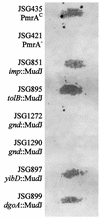Identification and genetic characterization of PmrA-regulated genes and genes involved in polymyxin B resistance in Salmonella enterica serovar typhimurium
- PMID: 12438352
- PMCID: PMC133008
- DOI: 10.1128/IAI.70.12.6770-6778.2002
Identification and genetic characterization of PmrA-regulated genes and genes involved in polymyxin B resistance in Salmonella enterica serovar typhimurium
Abstract
Salmonella enterica serovar Typhimurium encounters antimicrobial peptides (AP) within the phagosomes of professional phagocytes and at intestinal mucosal surfaces. Salmonella serovar Typhimurium utilizes the two-component regulatory system PmrA-PmrB, which is activated in response to the environmental conditions encountered in vivo, to regulate resistance to several AP, including polymyxin B (PM). Random MudJ transposon mutagenesis was used to identify PmrA-PmrB-regulated genes, as well as genetic loci necessary for PM resistance. Three different phenotypic classes of genes were identified: those necessary for PM resistance and regulated by PmrA, those necessary for PM resistance and not regulated by PmrA, and PmrA-regulated genes not required for PM resistance. Loci identified as necessary for PM resistance showed between 6- and 192-fold increased sensitivities to PM, and transposon insertion sites include surA, tolB, and gnd. PmrA-regulated loci identified included dgoA and yibD and demonstrated 500- and 2,500-fold activation by PmrA, respectively. The role of the identified loci in aminoarabinose modification of lipid A was determined by paper chromatography. The gnd mutant demonstrated a loss of aminoarabinose from lipid A, which was suggested to be due to a polar effect on the downstream gene pmrE. The remaining PM(s) mutants (surA and tolB), as well as the two PmrA-regulated gene (yibD and dgoA) mutants, retained aminoarabinose on lipid A. yibD, dgoA, and gnd (likely affecting pmrE) played no role in PmrA-regulated resistance to high iron concentrations, while surA and tolB mutations grew poorly on high iron media. All PM(s) mutants identified in this study demonstrated a defect in virulence compared to wild-type Salmonella serovar Typhimurium when administered orally to mice, while the PmrA-regulated gene (yibD and dgoA) mutants showed normal virulence in mice. These data broaden our understanding of in vivo gene regulation, lipopolysaccharide modification, and mechanisms of resistance to AP in enteric bacteria.
Figures




Similar articles
-
The biology of the PmrA/PmrB two-component system: the major regulator of lipopolysaccharide modifications.Annu Rev Microbiol. 2013;67:83-112. doi: 10.1146/annurev-micro-092412-155751. Epub 2013 Jun 17. Annu Rev Microbiol. 2013. PMID: 23799815 Free PMC article. Review.
-
Genetic and functional analysis of a PmrA-PmrB-regulated locus necessary for lipopolysaccharide modification, antimicrobial peptide resistance, and oral virulence of Salmonella enterica serovar typhimurium.Infect Immun. 2000 Nov;68(11):6139-46. doi: 10.1128/IAI.68.11.6139-6146.2000. Infect Immun. 2000. PMID: 11035717 Free PMC article.
-
PmrA-PmrB-regulated genes necessary for 4-aminoarabinose lipid A modification and polymyxin resistance.Mol Microbiol. 1998 Mar;27(6):1171-82. doi: 10.1046/j.1365-2958.1998.00757.x. Mol Microbiol. 1998. PMID: 9570402
-
Identification and functional analysis of Salmonella enterica serovar Typhimurium PmrA-regulated genes.FEMS Immunol Med Microbiol. 2005 Feb 1;43(2):249-58. doi: 10.1016/j.femsim.2004.08.007. FEMS Immunol Med Microbiol. 2005. PMID: 15681155
-
The Salmonella PmrAB regulon: lipopolysaccharide modifications, antimicrobial peptide resistance and more.Trends Microbiol. 2008 Jun;16(6):284-90. doi: 10.1016/j.tim.2008.03.007. Epub 2008 May 6. Trends Microbiol. 2008. PMID: 18467098 Review.
Cited by
-
The biology of the PmrA/PmrB two-component system: the major regulator of lipopolysaccharide modifications.Annu Rev Microbiol. 2013;67:83-112. doi: 10.1146/annurev-micro-092412-155751. Epub 2013 Jun 17. Annu Rev Microbiol. 2013. PMID: 23799815 Free PMC article. Review.
-
The PhoQ-activating potential of antimicrobial peptides contributes to antimicrobial efficacy and is predictive of the induction of bacterial resistance.Antimicrob Agents Chemother. 2007 Dec;51(12):4374-81. doi: 10.1128/AAC.00854-07. Epub 2007 Oct 15. Antimicrob Agents Chemother. 2007. PMID: 17938183 Free PMC article.
-
Comparison of Gene Expression Profiles of Uropathogenic Escherichia Coli CFT073 after Prolonged Exposure to Subinhibitory Concentrations of Different Biocides.Antibiotics (Basel). 2019 Sep 27;8(4):167. doi: 10.3390/antibiotics8040167. Antibiotics (Basel). 2019. PMID: 31569631 Free PMC article.
-
A link between gut community metabolism and pathogenesis: molecular hydrogen-stimulated glucarate catabolism aids Salmonella virulence.Open Biol. 2013 Dec 4;3(12):130146. doi: 10.1098/rsob.130146. Open Biol. 2013. PMID: 24307595 Free PMC article.
-
Antimicrobial peptide resistance in Neisseria meningitidis.Biochim Biophys Acta. 2015 Nov;1848(11 Pt B):3026-31. doi: 10.1016/j.bbamem.2015.05.006. Epub 2015 May 19. Biochim Biophys Acta. 2015. PMID: 26002321 Free PMC article. Review.
References
Publication types
MeSH terms
Substances
Grants and funding
LinkOut - more resources
Full Text Sources
Other Literature Sources
Medical

